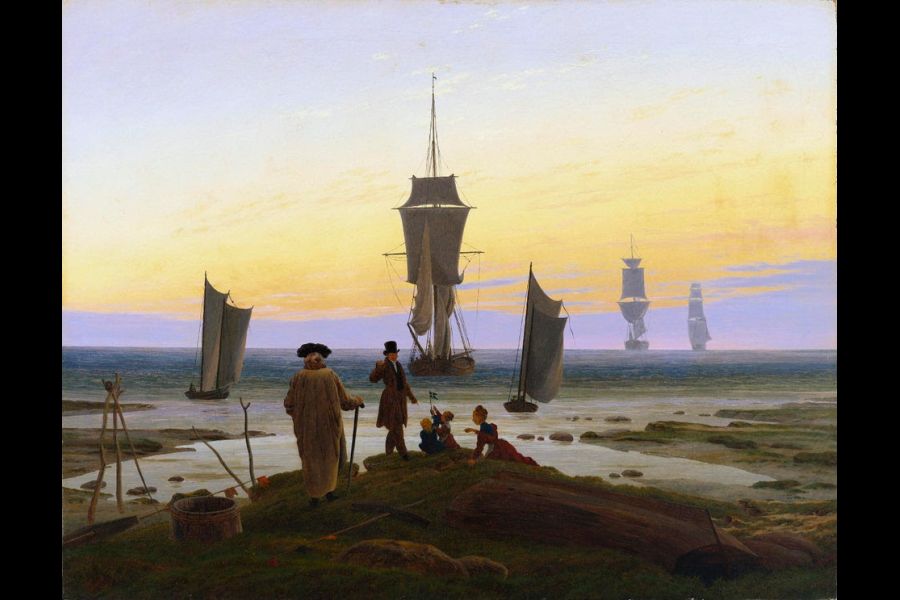Penny-Lynn Cookson
Special to Niagara Now/The Lake Report
A week ago, there was a spectacular sunset viewed from Ryerson Park. Jets descending into and rising above Pearson airport were making thin white streaks across a wide band of pink and lilac clouds resting on the horizon line of the grey still lake.
The golden rays of the setting sun which lay behind the clouds, cast a reflective light on the shore where isolated figures were taking photos or sat motionless quietly observing this fleeting moment of pure beauty. Such a contemplative scene brought to mind a 19th-century painting, “The Stages of Life,” by Germany’s most revered Romantic landscape artist, Caspar David Friedrich.
Friedrich was born in 1774, in a Baltic Sea town, Greifswald, then Swedish Pomerania, later part of Germany. He studied at the Copenhagen Academy and settled for good in Dresden.
He was a melancholy man whose mother and two sisters died of illnesses when he was young and then his beloved brother drowned before his eyes when he went through the ice on which they were skating. He did find family tranquillity later in life with a solid marriage, three children, a cherished godson and recognition as an acclaimed artist.
Although there was a taste for melancholy and mysticism in German art at the time, Friedrich adhered more to a philosophy that brought the unconscious life in nature to a conscious expression. He believed the artist should paint not only what was before him but what he perceived within himself.
He would stare at the blank canvas in his studio until the image “stood life-like” in his mind’s eye. Only then would he sketch it and paint it.
Composition first took place in his imagination. In his landscape paintings, space is always ambiguous, enigmatic, heightened by illumination. He preferred mists and twilight when the changing light and reflection enhanced colour and made the commonplace seem new and transcendent.
He aimed to create images that would encourage contemplation and alter the viewer’s mood so that the true meaning of the painting would be the emotion it evoked.
In “The Stages of Life,” five boats with sails billowing and furling are coming into port against a big twilight sky of pink, lilac, orange and yellow. In the foreground, an elderly man dressed for protection against a cool breeze, wears a long coat with a fur collar, and a fur hat.
He slowly but firmly makes his way on his cane toward a family group sitting by the shore. It is a self-portrait of Friedrich. His business-attired nephew and godson, Johann, gestures “Come join us” with his right hand while pointing with his left to the Friedrich children.
The small boy excitedly waves a Swedish flag as his sister tries to grab the flag while the older sister attempts to calm the two. We see five figures and five ships of varying sizes. The two small fishing vessels in the front allude to the two children. The two ghostly ships in the distance might represent the young adults with many unknown journeys ahead of them.
Only Friedrich looks on a diagonal to the horizon and to the central ship coming into harbour before darkness falls, suggesting a premonition of his own impending death. He suffered two debilitating strokes in the year of this painting, done from memory, and was dead in five years. By then he was nearly a forgotten figure.
A reappraisal of his work occurred in the 20th century. Much has been made of the symbolic meaning regarding life and death in his paintings. Certainly, the affection for family, the meaning and transience of life, the search for spirituality and belief in the immortality of the soul are present.
Friedrich, being a fatalist, left it to posterity to decide: “I am not so weak as to submit to the demands of the age when they go against my convictions. I spin a cocoon around myself; let others do the same. I shall leave it to time to show what will come of it: a brilliant butterfly or a maggot.”
In the 21st century, Friedrich’s work is acknowledged as “butterfly” and is even more resonant as we long for spring and being once again with family and friends sharing and in awe of a beautiful sunset.
Penny-Lynn Cookson is an art historian who taught at the University of Toronto for 10 years. She also was head of extension services at the Art Gallery of Ontario. See her upcoming lecture series “Art and Revolution, From Cave Art to the Future” Thursdays on Zoom until April 29 at RiverBrink Art Museum in Queenston.










